
The recent introduction of a modern Leica CL has focused attention on the original CL from the 1970s. ‘CL’ stood for ‘compact Leica’, a compact rangefinder camera, which was manufactured in Japan by Minolta for Leica between 1973 and 1976. Minolta also sold a version of the camera called the Leitz Minolta CL and later Minolta developed a more advanced version called the Minolta CLE.
Whatever happened to the Leica CL? Many consider it was too good for its boots. It arrived at a time of great flux in Wetzlar, when the company was undergoing yet another identity crisis. The popular and successful M4 had been superseded by the advanced — very underrated but ultimately too ‘unconventional’ for mainstream success — Leica M5. The M5 model was produced in small numbers between 1971 and 1975. Despite its advanced features, including light metering, it wasn’t well received, not least because of its large size. In desperation, Leica brought the M4 back from the dead, shortly before the company’s Canadian phase when the unmetered Leica M4 re-appeared in two new guises, the M4-2 and the M4-P.
But in the background at this time was the Leica CL, a smaller camera which was designed in cooperation with Minolta and intended to be a more compact rangefinder alternative to the M5, but sharing some similar features such as metering. After its launch in 1973 it succeeded in that goal. Too well, unfortunately. Many adopted it because they wanted the light metering ability of the M5 but in a smaller package. The CL outsold the M5 (65,000 v 33900 according to the production numbers) and many believe that this is the reason Leica halted manufacture in 1976. It would be another eight years before light metering came to the M with the introduction of the M6.
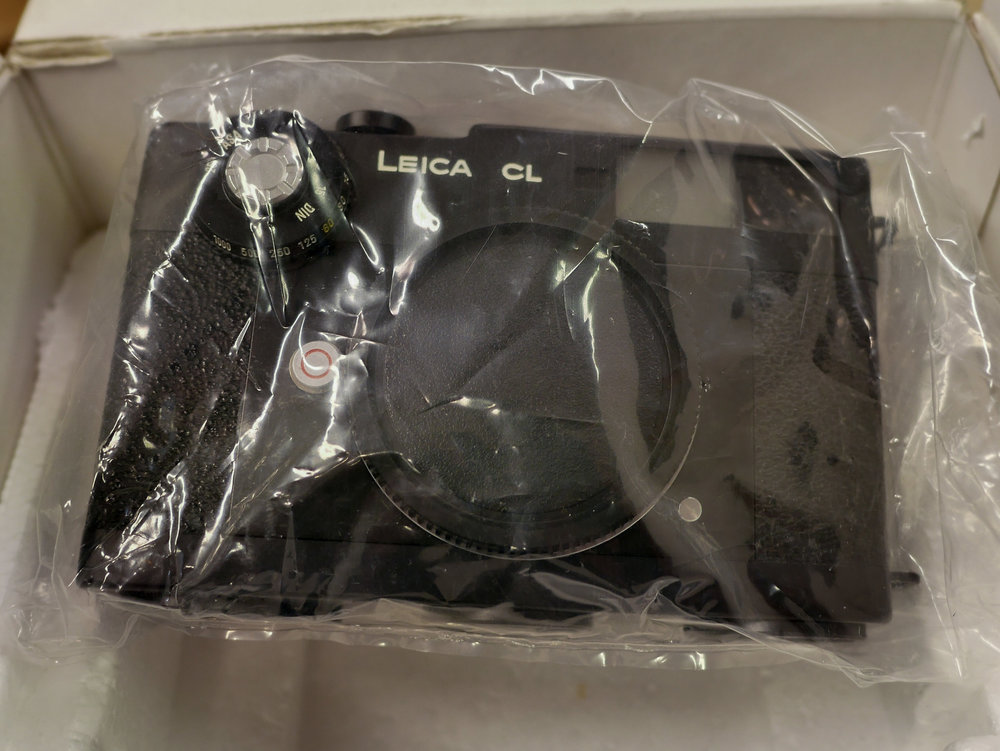
Admirers
Designed jointly by Leica and Minolta and manufactured by Minolta in Japan, the Leica CL is often considered a “mutant” camera, even sometimes being labelled as “not an actual Leica” by Leica purists. But the truth is that this unconventional pairing of manufacturers has been a primary reason for the camera developing a close group of admirers.
The Leica CL is a 35 mm compact rangefinder camera with interchangeable lenses in the Leica M-mount. It first appeared in April 1973 and was released in the Japanese market in November 1973 as the Leitz Minolta CL. Both the Leica CL and Leitz Minolta CL were manufactured in a new Minolta factory in Osaka.
The Leica CL has a vertical-running focal-plane shutter, with cloth curtains, giving ½ to 1/1000 speeds. There is a through-the-lens CdS exposure meter mounted on a pivoting arm just in front of the shutter, similar to that on the Leica M5. The exposure is manual and is set using a needle system. The shutter is mechanical, but the shutter speed set is visible in the viewfinder just like the M5. The camera can still be used without any battery. There were two special C lenses produced for the camera, a 40mm f/2 and a 90mm f/4, both made in Germany. The finder’s framelines are for a 40mm, 50mm or 90mm lens. The 40mm and 50mm framelines appear when a 40mm or 50mm lens is mounted and the 40mm and 90mm framelines appear when the 90mm lens is mounted.
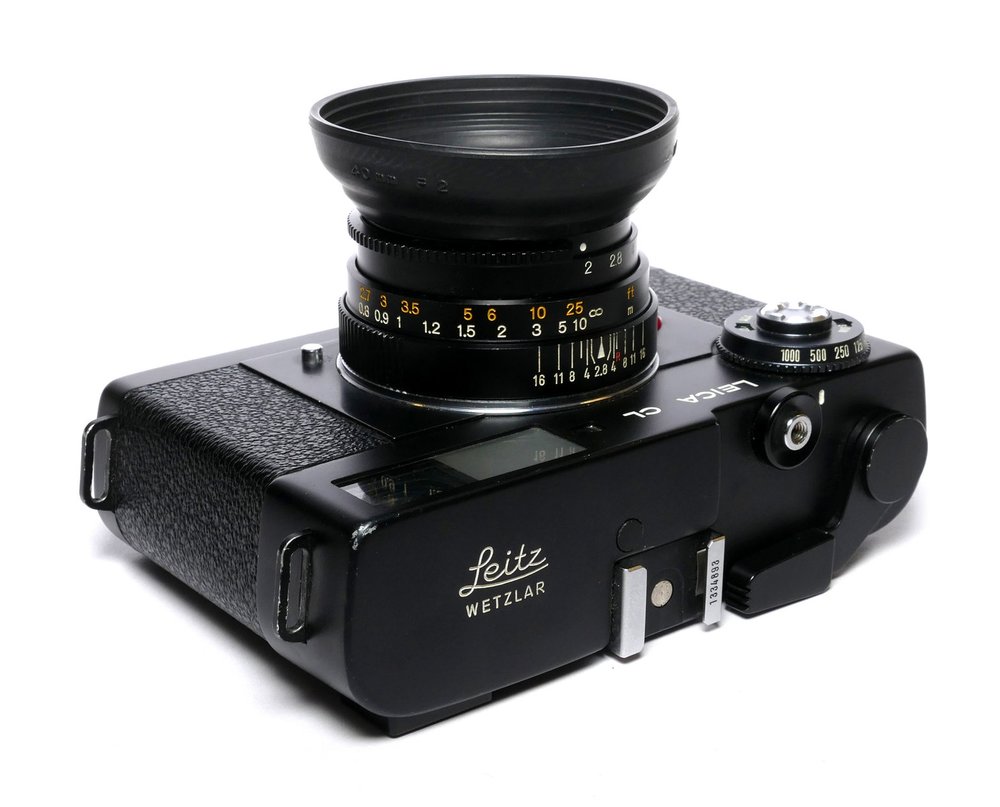
The original CL is a superbly compact and relatively cheap camera on which to use M-mount lenses, but it does not have a rangefinder as precise as that of any Leica M body. The rangefinder base of the CL is 31.5mm and the viewfinder magnification is 0.60, leading to a small effective rangefinder base of 18.9mm. This is probably too short for accurate focusing with lenses longer than 90mm and fast lenses used at full aperture. Some users report the camera is rather fragile, especially the rangefinder alignment and meter mechanism.
Sixty-five thousand serial numbers were allotted to the Leica CL, and this number does not include the Leitz Minolta CL. 3,500 examples of the CL received a special “50 Jahre” marking in 1975, for Leica’s 50th anniversary.It is also said that 50 demonstration examples were made. They are completely operational, with the top plate cut away to show the internal mechanism.
Here is an example of the 50th anniversary model from William’s collection with the 40mm and 90mm lenses, a special leather purse to contain the camera plus 40mm lens and a thin haze filter which fits between the rubber lens hood and the front element on both lenses.
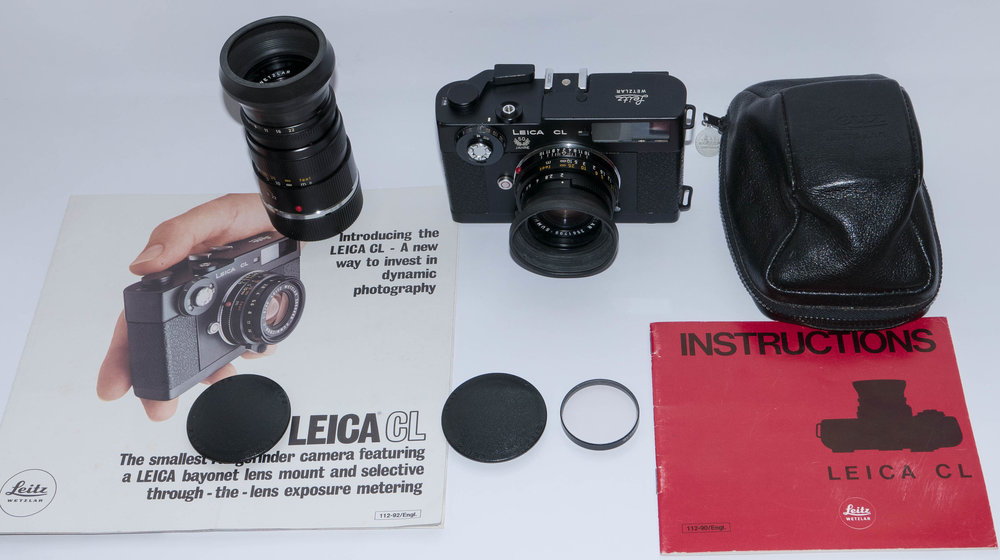
Leica M5
The Leica M5 is a 35 mm camera by Leica Camera AG, introduced in 1971. It was the first Leica rangefinder camera to feature through-the-lens (TTL) metering and the last to be made entirely in Wetzlar by hand using the traditional “adjust and fit” method.
Leica M5 sales were very disappointing, and production was halted in 1975 after 33,900 units (from 1287001 to last serial number 1384000; 10750 chrome and 23150 black chrome bodies). Cost was an issue for the M5 body. In today’s currency (Consumer Price Index Integer) the price is around $4200.
Rangefinder camera sales were seriously undermined during this period by the predominance of mass-produced SLRs, primarily from Japan. In addition, Leica continued selling the M4 in 1974 and 1975, and the Leica CL was fully represented in the market by 1973. The UK Leica catalogue for 1975 lists the M4 and M5 and the CL.
Often cited as also contributing to the poor sales are the larger size and weight, the departure from the classical M design, the impossibility of attaching a motor winder, as well as the incompatibility with certain deep-seated wide angle lenses and collapsible lenses (i.e. 28 mm Elmarit below serial number 2 314 920) – see furher details below.The larger body dimensions also prevent the use of many M series accessories, such as external hand grips, quick release plates for tripod heads, or the Leica Lens Carrier M. The M5 is actually wider than the Nikon F, the camera that started the slide in the fortunes of Leica. There is an interesting story beyond the scope of this article about how the Leica company ignored the warnings about the threat from SLRs from its own engineers and then delayed the introduction of the Leicaflex until it was too late to recover. The M5 represents a failed attempt to make up lost ground.
Leica reverted to the M4 and its M4-2 (often called ‘the camera that saved Leica’) and M4-P developments, until the coming of the Leica M6, which offered built-in metering, albeit through the use of more electronic circuitry, while retaining the classic M design.
Here is a size comparison photo of some items from William’s collection, including a CL with 40mm f/2 Summicron and the M5 with a chrome 50mm f/2 Summicron and the M4-2 with a black 50mm f/2 Summicron. For proper comparison the M4-2 is wearing an MR light meter as the other two cameras have built-in metering.
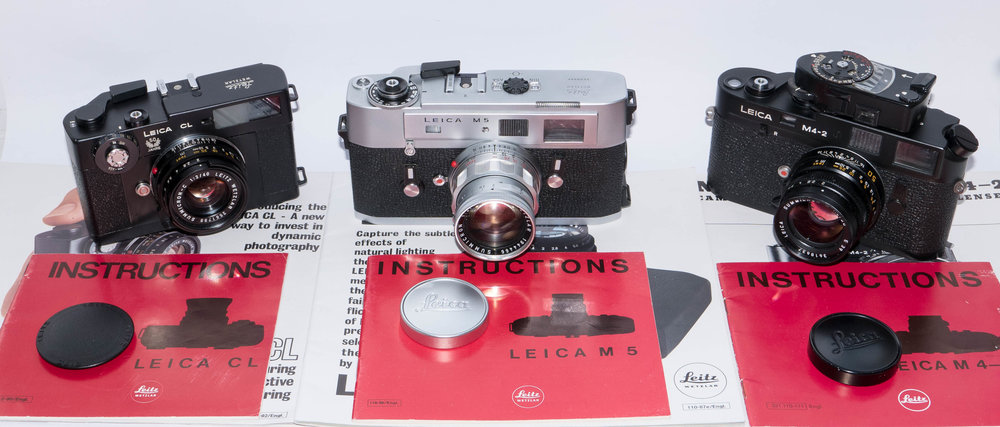
The M4-2 can be used with the M4-2 winder, which William has, but he decided not to mount it as neither of the other two cameras can be used with winders.
The CL and the M5 were designed to be used with PX 625 1.35 volt mercury oxide batteries, which were subsequently banned. They can be used today with Wein Cells or be modified to take modern PX 625 A 1.5 volt alkaline batteries. Williams article here deals with these issues in the context of an M5.
The M5 is now a relatively uncommon type, and their price on the second-hand market is comparable to that of the M6. M5s were discovered by Japanese collectors in the late 1990s and their price experienced a sharp rise at that time.
Lenses for the Leica CL
The CL was sold with two lenses specially designed for it: the Leitz Summicron-C 40mm f/2, sold as the normal lens, and the Leitz Elmar-C 90mm f/4 tele lens. Both take the uncommon Series 5.5 filters. A Leitz Elmarit-C 40mm f/2.8 was also briefly produced but it is said that only 400 were made and they are now valuable collectors’ items
The lenses specially designed for the Leica CL can physically mount on a Leica M body, but Leica recommended not doing so because it would not give the best focusing precision, allegedly because the coupling cam of the C and M lenses is not the same. However, some people say that it is unimportant and that they can be used perfectly well on an M. Indeed in Williams experience he finds that the 90mm C lens is one of the most accurate 90mm lenses on an M.
When sold with a Leitz Minolta CL, the lenses were called Minolta M-Rokkor 40mm f/2 (later just Minolta M-Rokkor 40mm f/2) (see picture at top) and Minolta M-Rokkor 90mm f/4. It is said that the 40mm was made in Japan by Minolta while the 90mm was made by Leitz and is rare. With the later Minolta CLE, Minolta would produce lenses of the same name but with a different coupling system, the same as the Leica M lenses. A new Minolta M-Rokkor 28mm f/2.8 lens was introduced as well. All these lenses can be mounted on the CL too. Rokkor-branded lenses for the CL and CLE take the more easily found 40.5mm filter size.
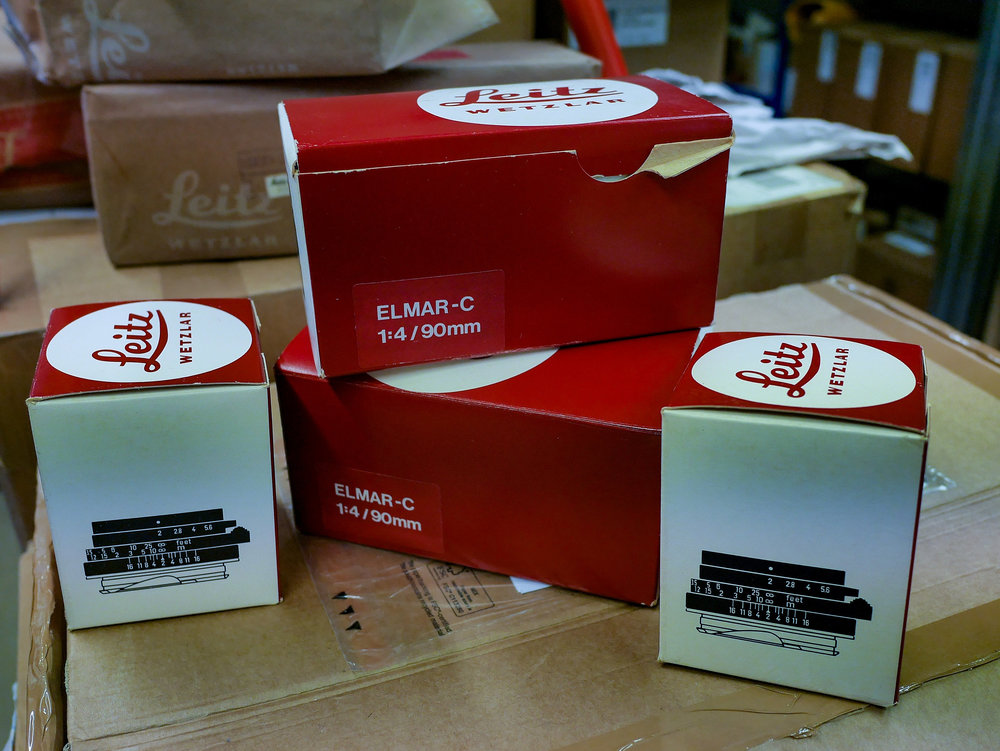
The CL can take nearly all the Leica M lenses. Exceptions are some lenses that protrude deep into the body and could hurt the meter arm, which resembles a swinging lollipop. Such lenses include hese include: 15mm/8 Hologon, 21mm/4 Super Angulon, 28mm/2.8 Elmarits before serial number 2314921. The eyed lenses, including the M3 wide-angle lenses, the 135mm/2.8 Elmarit, and the 50mm/2 Dual Range Summicron, cannot be mounted either because they are incompatible with the body shape. The 90mm/2 Summicron and 135mm/4 Tele-Elmar are incompatible too. The collapsible lenses can be mounted but they must not be fully collapsed to avoid contact with the meter on a ‘swinging lollipop’ and Leitz advised to stick an adhesive strip of adequate width to the barrel, to limit the collapsing movement. Another limitation is that the rangefinder is only coupled until 0.8m. The same issues also apply to the M5, which also has its meter on a similar swinging arm, visible here.
William had to put an adaptor on this M5 in order to persuade it to show its ‘lollipop’.
.jpg)
Resurrection
The CL was consigned to history and, eventually, Leica got itself back on track with the M6, the M7 and, latterly, with a blossoming range of digital Ms.
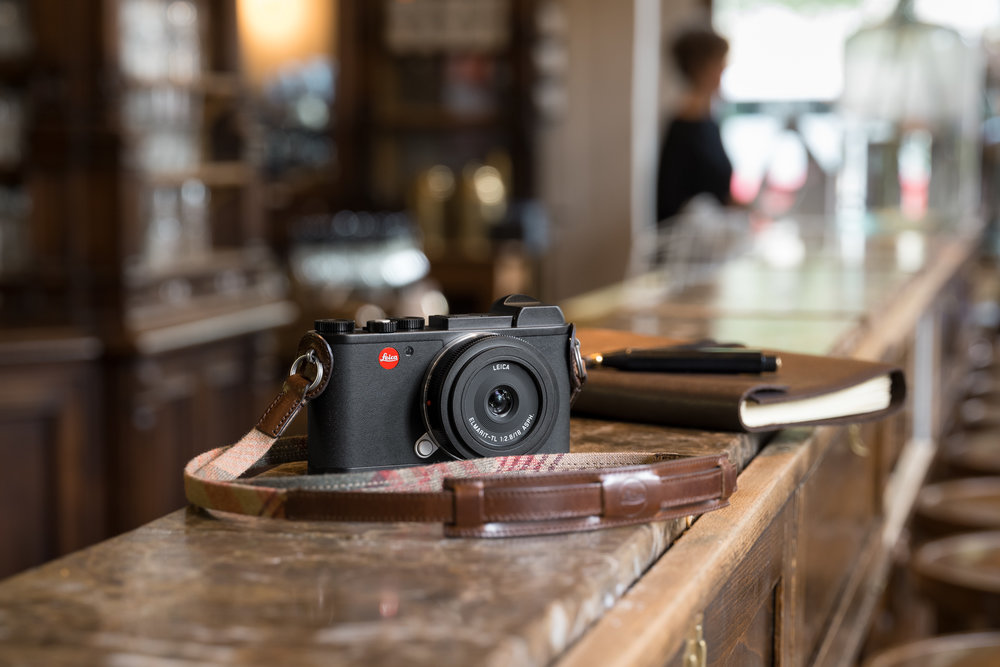
The CL, as a film camera of course, was potentially just as capable as the M4 and M5. They were all, as we say these days, full frame. In those days full frame meant ‘not half frame’. It is interesting also that, whereas in the 1970s Leica was trying to make up ground on cameras with flapping mirrors, these days Leica seems to have left flapping mirrors behind with its move to EVFs. A whole new era of Compact Leica (CL) photography has commenced with the launch of the new CL with EVF last autumn.
Some more information on the Leitz-Minolta CL
___________
- Subscribe to Macfilos for free updates on articles as they are published
- Want to make a comment on this article but having problems?

I bought my current CL from a boy who’d bought it (refurbished) from Ivor at Red Dot. You didn’t mention that it has a VERY noisy shutter (..that fast, vertically-running shutter also has to stop fast! ..and which, presumably, Leitz weren’t geared up to manufacture, having the whole lot done for them by Minolta, whom they also had to pay for all that work, and all those cameras..) and it’s far noisier than the bigger, heavier M5 ..and noisier, too, than its successor, the sweet, quiet Minolta CLE of 1980.
But the light weight – as well as smaller-than-normal-Leica size – of the CL is what made it so great. The vertical shutter-speed dial was simple to set with one finger, while easily – more easily than the M5 – seeing both the selected speed and the light-reading in the finder! This was a real departure, and a big deal, for Leicas ..which, till then, and till the M5, had had only external clip-on meters, which were sold as optional extras.
Leitz not only shot themselves in the foot by producing two cameras with almost identical capabilities ..but with one much smaller and lighter than the other.. but effectively cut their own throat by making that smaller CL cheaper, and thus a better-seller than the bigger, heavier M5 ..while also having to pay Minolta to produce the CL which both cannibalised and decimated the sales of their own in-house M5..!
The CL was (..and is!..) also far faster and easier to load with film than any other Leica rangefinder, because you just pull off the bottom of the camera, and the camera back slides off with it, and with the pressure plate dropping open, so that it’s quick to drop in a film cassette, pull the film to the take up spool, flip up the pressure plate over the film and slide on the combined back-and-bottom again.
It has a clean and simple top plate – with the rewind knob underneath the camera, like the little Rollei 35 – an extremely simple opening catch (..surrounding the CENTRAL tripod socket ..NOT off to one side!..) and with very easy access to the light-meter battery (a single 625 cell).
In comparison to this lightweight, ‘snapshot’, CL – and to the then-contemporary all-conquering Pentax Spotmatic SLR – the very heavy, but accomplished, Leica M5 looked, and felt, rather like the dinosaur that it was.
Thanks, David. All good extra information to add to the discussion and thanks for going into so much useful detail.
Mike
Thanks for your comments, David. I would not describe the shutter of the CL as being that noisy. It gives more of a ‘clunk’ sound like the early LTM models or some SLRs. The M5 shutter is quieter, but you have to press the shutter way down in order to shoot, giving rise to the possibility of camera shake as your finger hits the shutter speed dial which contains the release. A so-called ‘soft release’ is recommended for use with the M5. Of the 3 cameras shown above, the M4-2 has the nicest shutter with release at just the right position and a quiet sound.
Yes, the CL film loading is nicer, once you figure out the procedure with the pressure plate. Your point about the cost of paying Minolta is a valid one and should be borne in mind by people who are looking for a new D-Lux, which is a Lumix camera with a Leica badge, just like a Vauxhall is a German Opel with a different badge. Vauxhall and Opel are part of the same group, however, but Leica has to pay license fees in order to re-badge a Panasonic camera. The Leica strategy in the 1970s seems to have been driven by engineers rather photographers. A friend of mine, who is an internationally renowned camera collector, has the strong view that the best cameras were always those which seemed to have had some design input from photographers. He also tells me that the ‘swinging lollipop’ was already old technology by the 1970s and had been used earlier by others, including Canon, if I remember correctly. The ‘swinging lollipop’ was subject to damage and failure. Thankfully, Leica has survived and recovered from its wilderness years.
William
As one of the official photographers for the Munich Olympics of 1972 for which Leica were the official camera I was offered the free loan of either a comprehensive M5 outfit or likewise a very comprehensive Leica SL MOT outfit, but after much thought declined as I considered the Olympic Games far too important and difficult range of subjects to cover than to also risk having to learn my way round new equipment.
That said however I was and still am mightily impressed with the M5 which it is easy to forget was the Worlds first ever rangefinder camera with TTL metering, which in itself might not sound much of a advance given today’s massive technological advances, but believe me to us then this one factor alone was a enormous improvement, as was the M5’s rangefinder and viewfinder which is strangely is rarely picked up or commented upon nowadays.
Thus for me at least along with many other of my fellow Leica using Pro’s this made the M5 THE best rangefinder camera Leica ever made, and that continued to be the case for so many of us at least prior to the M7, and funnily enough most especially to our Japanese counterparts. Anyway although I chose not to avail myself of the Olympic free loan outfit I bought one instead, and later added a ’50 Year Anniversary’ model which I still have.
Additionally I bought a CL outfit complete with a special display box and still love that too, though i fully acknowledge the Minolta CLE version was much better, and more importantly now as I no longer shoot film I do use the film CL’s superb 40mm f2 Summicron and the 90mm on my modern digital CL as well occasionally on my MP240 where both relatively old lenses actually perform wonderfully well.
My view of what caused the demise of the wonderful M5 differs somewhat from William’s and Mike’s thus as what actually killed it of quite simply was the fact the affluent amateur Leica traditionalist just failed to accept change or reconise a good thing when they saw it, and so as Leica needed bulk sales, and hence were vastly reliant on the numerically far greater amateur buyers they ran scared and killed off arguably THE best camera they at Leica had ever made.
Don, I’m delighted you’ve come back so quickly on this. I was of course aware of your liking for the M5 — which we have discussed on a number of occasions — and I was tempted to suggest to William that we made reference to this as a counterpoint in the article. However, you make your case very well and I think this enhances our understanding of what went on back in the 70s. As for the headline, well, let’s not let facts get in the way of a good story!
Also, I forgot to say, the choice of CL for the new digital camera as something of a stroke of genius which, of course, hasn’t been lost on Leica historians.
You could well be right, Don. I was using much more humble cameras during the 1970s. As well as being unwieldy in shape and size, the thing that I really dislike about the M5 is that sharp little rewinder lever on the front which cuts right into the middle finger of my right hand and makes using the camera most unpleasant. A friend who repairs M cameras said the same thing to me last Tuesday when I showed him the camera. He suggested that he could mill down the sharp edges, but I, naturally, said that would destroy the camera’s ‘original condition’. I must admit, though, that the photos I have taken with my M5 using its own metering system have been excellent, as were the ones I have taken with my CL.
My favourite Ms are the M3, (I slightly prefer the Double Stroke model) because of the viewfinder and long rangefinder base and an M2 with button re-wind and no self timer which makes for perfect right hand grip. I have used a Nikon F from 1960 with just a simple prism finder recently and, although it is nearly as wide as the M5, it is much more pleasant to handle. It does not have metering, of course, and I have always felt that the Nikon Photomic meters were unwieldy. Leica’s metering solution was TTL and much more elegant. If Leica had not gone for the body size and shape of the M5 and not introduced the CL shortly afterwards, the M5 might have been a success, but we cannot re-write history at this stage.
William
Happy days William, But yet again may we remain happy to differ as when it comes to M3’s I much prefer my quite late version single stroke M3 to the glass plate double stroke model I started with. However my thanks to both Mike and yourself for reigniting the memories via such a wonderful article. Best wishes, Don